| Contact Us | Site Map | Affiliates | Home | Follow Us On: |

|
|
Location, Location, LocationChicago has rightfully been called the most "all-American" city, partly because it is in the nation's heartland and partly because all of the best that America has to offer is here. Like scenes from an old folk song, trains still travel to Chicago through amber waves of grain blanketing the prairie and arrive in a city that is anything but flat -architecturally or culturally. It all started as little more than a swampy bog. Local Indians called it Shikaakwa, which means "striped skunk" or "the smell of onions." Evidently the stench was not enough to keep away those who could smell the capitalistic opportunities that would come from being located on the shores of Lake Michigan and the banks of the Chicago River. They knew that once a canal would connect the Chicago River with the Mississippi, the final link of a water route from the St. Laurence Seaway to the Gulf of Mexico would be in place and the money would flow, too. Chicago is not just "all-American" because of its centralized location. The impact the city has had on American culture is priceless. Chicago-style blues hugely influenced rock-and-roll. That's the same kind of blues that Jake and Elwood played in The Blues Brothers (what many still call the greatest Chicago movie). Real life outlaws like Al Capone and John Dillinger have cemented the city's image with gangsters. Perhaps the only more recognized faces connected with Chicago today are Oprah Winfrey and Michael Jordan. Many other "all-American" inventions like pinball, roller skates, revolving doors, Playboy Magazine and even the skyscraper came from Chicago. Tourism
One can do and see a lot of great things in the City of Chicago, but there is definitely something that can not be done: See everything in one trip. That is unless your vacation is five years long. But if, like most working folks, your visit to Chicago is limited to a long weekend, a week, or even 10 days, then a little research and planning can go a long way. Chicago is the third most populated city in America (only behind New York City and Los Angeles) so this is a big place with a lot of people. Wherever your interests lie, odds are Chicagoland has it. According to the Chicago Convention and Tourism Bureau, the number one tourist attraction in Chicago, by far, is Navy Pier, which lures well over 8 million visitors annually. The Lincoln Park Zoo and John. G. Shedd Aquarium are next on the list, each bringing in millions of patrons every year. Chicago's major museums -the Art Institute of Chicago, Museum of Science and Industry, and Field Museum -generate massive tourism dollars into Chicago's economy, as well. Sports
When Carl Sandburg dubbed Chicago "The City of the Big Shoulders," you have to wonder if he had the Chicago Bears in mind. From the days of Bronko Nagurski and "The Monsters of the Midway" to '80s fan-favorite Refrigerator Perry, da Bears have been one thing: Tough. Er, make that big and tough. Consider this: Since literally founding the NFL in 1922, the Bears have gone on to send more players to the Pro Football Hall of Fame (26) than any other team. They reached the astounding milestone of 600 victories quicker than any other club. And in the process, they gave us household names like Walter Payton, Mike Ditka, and the immortal "Red" Grange. Ditka lead the Bears to a Super Bowl win in 1985 and though it has been over two decades to bring home The Vince Lombardi Trophy, the pride remains. Hope springs eternal each April as diehard Cubs fans once again converge on the friendly confines of Wrigley Field in an effort to cheer their beloved team on to victory. Baseball purists agree there's no better place to see a game; and it's easy to see why. The ivy-covered walls, daytime games, and hand-operated scoreboard all combine to take one back to the halcyon days of our national pastime when the Cubbies last won it all in 1908. Across town, Southsiders are equally passionate about their storied White Sox, and cheer with a gusto that is legendary to opposing clubhouses. Downtown Chicago was electrified in 2005 when the White Sox brought home a World Series championship after a 4-game sweep of the Houston Astros. The two Chicago teams last met in a World Series in 1906, with the White Sox taking the prize. Modern bragging rights are at stake when the Cubs and White Sox square off for a series each summer. When the cold winds blow down from the Canadian prairie signaling the start of winter, the toughest Chicagoans don't fret. Instead, they zip up their parkas and head straight for the United Center to watch their beloved Blackhawks lace up their skates. The Blackhawks take their name from a crack battalion of machine-gunners in World War I (nicknamed the "Blackhawk Division,"?after the Native American Sauk Chief Blackhawk.) The team rewards their fans with some expert shooting -and fighting -of a different kind. The 'Hawks last hoisted the Stanley Cup in 2010 and always fill the scarlet and black game sweaters out with an excellent squad. It is easy to have a one-word name if you opt for something unusual like "Sting" or "Madonna." Not so easy, though, if your name is Michael. Yet that is exactly what Michael Jordan accomplished in his tenure with the Chicago Bulls, during which they won an unprecedented six World Championships in an eight-year period. The Bulls, of course, have been a fixture in Chi-town since 1966. It took Michael, along with Scottie Pippen and guru Phil Jackson, to make winning a fixture. In the Second City, it was the Bulls who made Chicago a synonym for champions. That's why through thick and thin, Chicago loves their Bulls. Music
If, as they say, "The blues had a baby and they named it rock n' roll," then Chicago bluesmen like Willie Dixon and Muddy Waters can argue which one is the daddy. They migrated to the Windy City from the Deep South to taste a slice of the American Dream and quickly discovered that Chicago crowds liked to dance, not just listen. So Waters plugged in an electric guitar, backed by a full band complete with trap kit, and Chicago-style blues was born. Chicago's legendary Chess Records captured the sound on vinyl and presented the likes of Waters, Howlin' Wolf, Chuck Berry, and Bo Diddley to the world. Before Dixon wrote songs like "I'm Your Hoochie Coochie Man" and "The Little Red Rooster," which became the glue between blues and rock, he was the Illinois State Golden Gloves Heavyweight Champion. You couldn't mess with Willie in the studio or the ring. It is hard to estimate just how much these musicians have influenced rock n' roll, but consider the Rolling Stones took their name from a Waters' tune and scored a #1 hit with one of Dixon's. Other local blues greats include Otis Rush, Pinetop Perkins, Koko Taylor, Buddy Guy and Lonnie Brooks. Also setting up residence in Chicago have been some of the greatest names in jazz history, including Jelly Roll Morton, Louis Armstrong, Bix Beiderbecke, Nat King Cole and Benny Goodman. Today, jazz purists frequent local clubs like Green Dolphin Street and The Green Mill, which has been on a strict jazz-only diet since the nights that Al Capone was a regular. There are a slew of blues and jazz festivals and events in Chicagoland throughout the year, like the Grant Park-based Chicago Blues Festival that draws well over a half-million blues fanatics annually. One local organization dedicated to the important work of preserving the legacy of the blues is Willie Dixon's Blues Heaven at 2120 S. Michigan Ave., the former home of Chess Records. The Windy City has been the subject of more than a few songs over the years, from "Sweet Home Chicago" to "The Night Chicago Died." And wasn't it from "Bad, Bad Leroy Brown" we learned that the South Side of Chicago is the baddest part of town? True, the city isn't mentioned in all songs, and not all bands are from Chicago, but if an act is worth their weight in gold, platinum, or veruca salt, sooner or later they'll be playing Chicago. One of the hardest working rock bands in show business, Chicago, was formed around a kitchen table in a small North Side apartment. Their unique sound combines the power of rock n' roll with the sophistication of swing and jazz and has paid off jaw-droppingly nice with over 120 million records sold. Also formed on the North Side, '60s soulsters The Impressions, were led by two-time Rock n' Roll Hall of Famer Curtis Mayfield, who also had a great impact on funk and rap. International fame and heavy radio rotation have also been friendly to other '70s-born rock bands that the region produced including Cheap Trick and Styx. The most commercially successful rock band to emerge from the city in the 1990s, The Smashing Pumpkins, played their debut and farewell shows (12 years apart) at Chicago's Metro. With little radio play and even less glam, Wilco has flown under the pop-culture radar just low enough to remain less than a household name, but just high enough to attract the ears of a faithful international following. Jeff Tweedy carved out their alternative-country niche in the mid-'90s in Chicago and they have remained a local favorite. Alternative folk rock crooner Liz Phair was raised in Winnetka, and R&B badboy R Kelly is from the South Side. Rappers Kanye West and Common both hail from Chicago, as well. If you want to catch the next Veruca Salt, Urge Overkill or even Chicago, there are many music venues to keep your eye on, including The Metro, Empty Bottle or Schuba's. To stay current on the latest band listings, check the Reader or Tribune. Chicago is the cultural center of the Midwest, so it should come as no surprise that so many sophisticated classical music opportunities abound. The Chicago Symphony Orchestra (CSO), which has become one of the world's most highly regarded orchestras, is currently in front of Riccardo Muti . The baton was previously held by Daniel Barenboim from 1991 to 2006 and Sir Georg Solti from 1969 to 1991. Solti holds the distinguished title of having won the most Grammy Awards in history. In music, it doesn't get much better than that. The symphony can be seen and powerfully heard September-May at Orchestra Hall and often in the summer months at Ravinia, an open-air venue on the North Shore.
The Chicago Sinfonietta concentrates on classical and romantic pieces as well as "imaginative new works by composers and soloists of color." Chamber music lovers may enjoy the ever-rich Chicago Chamber Musicians, but if you're going for baroque, you'll want to hear Music of the Baroque and Chicago Baroque Ensemble. Of course, there is nothing richer than a human voice. Perhaps that's why one of the hottest tickets in town is the Lyric Opera of Chicago, which has been wowing opera lovers across the globe for over 50 years. Gospel music owes much to Chicago's South Side Baptist churches who've nurtured stars like the late, great Mahalia Jackson and Thomas A. Dorsey from Pilgrim Baptist Church in Bronzeville. Since the World's Columbian Exposition of 1893, Chicago knows how to throw a street party. A huge population of talented musicians with rich ethnic diversity is the formula for a city calendar that is jam-packed with music festivals. Since snowy months do not naturally lend themselves to walking barefoot in Grant Park, even more events are packed into the days of summer. Jazz and blues reign supreme on Chicago outdoor stages, but that should not come as a surprise with the city's incomparable influence on those styles. These days, most outdoor festivals include one form of music or another, but there are certain events where the jam sessions on stage are the main attraction. Whoever your favorite artist is, odds are that sooner or later you will find them gazing out from a Chicago stage at an audience under the stars. Art and Architecture
The Art Institute of Chicago on Michigan Avenue is a virtual wonderland of culture. As one of the world's most highly regarded museums, the Art Institute displays a collection of masterworks spanning 5,000 years. Highlights include Edward Hopper's Nighthawks, Mary Cassatt's The Child's Bath, and the oft-parodied American Gothic by Grant Wood. The collection is spectacular, with countless pieces from Europe, Asia, the Americas and Africa. The Institute's Impressionist collection includes Monet, Renoir, Degas, van Gogh, Gauguin, and the legendary George Seurat's A Sunday on La Grande Jatte. Amazing collections like this are the result of the generosity and foresight of numerous Chicagoans like Bertha Palmer, who bequeathed the city a tremendous collection. America's largest contemporary art museum is the Museum of Contemporary Art at 22 East Chicago Avenue. The museum, which opened its doors in 1996, focuses on work post-1945. Once inside, patrons enjoy a permanent collection that includes Joseph Beuys, Franz Kline, Rene Magritte, Cindy Sherman and Andy Warhol.
Chicago is home to some of the world's tallest buildings, including Willis Tower, The Aon and John Hancock centers. Visitors can shoot up to the observatory on the 94th floor in the world's fastest elevator at the Hancock. Theater, Television and Film
In Chicago, theater is serious business. Unless you're feeling funny that is, in which case Second City may be your best bet. Whatever your mood, the city's scores of theaters provide entertainment the old-fashioned way -real and live. Many Broadway hits find a home (and sometimes their first runs) in Chicago's Loop Theater District, which houses several classic beauties, including the Chicago Theater, Cadillac Palace Theater, Goodman Theatre, and Ford-Oriental Theater. The latter, originally named the Iroquois Theatre, played an unfortunate role in Chicago history when it suffered a devastating fire in 1903, killing 603 people. In recent years, the only spark ignited by Loop theaters is Chicago's downtown nightlife. Chicago actors have always been innovative. American improv as we know it -often allowing the audience to direct the plot -saw its birth at The University of Chicago in the 1950s. Two decades later, local thespians reasoned, "There's Chicago-style architecture, Chicago-style blues, even Chicago-style pizza, so why not Chicago-style theater?" So the intricate set designs were stripped and the acting got loud and physical. Among the creators of the Chicago style were local actors Gary Sinese and John Malkovich, who also helped found Steppenwolf Theatre in Lincoln Park. Other Lincoln Park venues include the Apollo, Royal George, Victory Gardens and the Briar Street, which is the Chicago home of Blue Man Group. Choosing the right show may be overwhelming with so many performances around town, but making the decision easier are Chicago newspapers and The League of Chicago Theatres, which offers internet updates and tickets at half-price for certain productions via their Hot Tix booths. Since 1959, Second City has become an American icon and breeding ground for household names like John Belushi, Dan Aykroyd, Joan Rivers, Mike Myers, Bill Murray, Alan Alda...well, the list goes on. Other Chicago comedy hotbeds include names like Zanies, ComedySports, and ImprovOlympic. In the early 1900s, Essanay Studios in Chicago's North Side was the place to make silent films. The likes of W.C. Fields and Charlie Chaplin eventually moved to Hollywood, but since those early days the city has been the backdrop for countless American classic movies from the 1932 Scarface to Ferris Bueller's Day Off. Local film buffs can take in a variety of celluloid indulgences including several local film festivals, such as the Chicago Underground Film Festival, Fast Forward Film Festival, and The Chicago International Film Festival, America's oldest competitive film festival. There are also a slew of historic movie houses in Chicago -some grand and romantic, some underground and raucous. The Gene Siskell Film Center, named for the late Chicago Tribune movie critic, is the cinematic arm of the School of the Art Institute. Hundreds of shows have been shot in Chicago for the small screen from the mega-popular Oprah Winfrey Show to the mega-irreverent Jerry Springer Show -and just about everything in between. The Mayor's Office of Special Events has a special arm, The Chicago Film Office, which spearheads local efforts to attract film and television production (fine and commercial) to shoot in Chicago. The office's website gives a list of famous movies and television shows filmed in Chicago. Business
When Ol' Blue Eyes sang "State Street, that great street," he was merely acknowledging a fact: downtown Chicago was then, as now, the quintessential American shopping district. Consider this: Chicago gave the world Sears, Montgomery Ward, Walgreens, and Marshall Field's -names that have become so ensconced in the collective consciousness of consumers as to actually define what it means to shop. The Loop, an area of downtown Chicago so designated for the elevated trains that neatly circle it, is home to a dizzying array of stores and merchandise. Just a bit closer to the lake that gives it its name, Michigan Avenue is a modern, luxurious shopper's delight. The stores along this "Magnificent Mile" are instantly recognizable to any visitor. The first great commercial catalogs of Montgomery Ward and Sears appeared in Chicago; and thus ushered in an era of broad-based consumption that naturally gave rise to modern advertising. Some of the most legendary ad campaigns emanated from the shores of Lake Michigan. When Schlitz was dubbed, "The beer that made Milwaukee famous"; when the television announcer said, "Aren't you glad you use Dial?"; and when Tony the Tiger roared, "They're G-r-r-reat," Chicago's mighty agencies were behind the campaigns. The strength of the local economy rests squarely on the Big Shoulders of the city's diverse business services and infrastructure. In his beloved book On the Mississippi, Mark Twain wrote, "It is hopeless for the occasional visitor to try to keep up with Chicago . . . Chicago is always a novelty; for she is never the Chicago you saw when you passed through the last time." The Institute of Real Estate Management also makes its home in Chicago, reflecting the enormous role of commercial and residential leasing in Chicagoland. While there is no doubt that Chicago's meat-packing industry is the most famous in the world, sirloins and T-bones aren't the only thing on the menu. The Chicago-style hotdog is a unique creation in and of itself. Of course, no trip to Chi-town is complete without at least one helping of Chicago deep-dish pizza. This is the stuff that tourists dream of when they go back home. The rise of Chicago as one of the world's great cities was inextricably tied to the development of financial institutions and exchanges in the mid-19th Century. With unparalleled access to commodities, natural resources, and sophisticated transportation networks, the business leaders of early Chicago were instrumental in creating the mechanisms by which capital could be readily accessed and injected into the American marketplace. Without these financial innovations, Chicago would have been unable to capitalize on any of its natural advantages, and would today be but a shadow of its current self. The Chicago Board of Trade was organized in 1848 as an affiliation of prominent businessmen seeking to establish the procedures, standard and infrastructure required for mass shipments of commodities. In 2008, the Board was purchased by the Chicago Merchantile Exchange, joining the two financial institutions as CME Group, Inc. The Windy City is also home to the Chicago Board of Options Exchange and the Chicago Stock Exchange. Ray Kroc built a trillion-dollar enterprise, initiated a global phenomenon, and spawned hundreds of imitators with a little restaurant named McDonald's. And he did it from Chicago. Kroc, like so many other local entrepreneurs, was more of an innovator than an originator. He took a good idea from a San Diego restaurant and made a phenomenal story. He is just one in a long line of Chicago entrepreneurial greats. The city's media doesn't just reach Chicagoland - it reaches the world. Chicago is now home to dozens of English language newspapers, including the Chicago-Sun Times, Chicago Tribune and the pioneering Chicago Defender, one of the nation's most powerful African-American newspapers. The gold standard by which broadcast media measures itself - the Nielsen Ratings - is also a product of Chicago. Fans of the media can find information on the Neilsens, and more, at the Chicago Museum of Broadcast Communications. It's no accident that Chicago developed as a manufacturing center, or that industry has managed to remain vibrant while manufacturing has floundered in other parts of the country. The reason for Chicago's resilience and dominance is a combination of diversity, innovation and infrastructure. Chicago, for example, was never simply a steel town; but instead used its mighty steel mills as essential building blocks in a grander scheme. Thus the furnaces at Illinois Steel (later U.S. Steel) were used to fuel the economic engine of railroads and shipbuilding. |
||


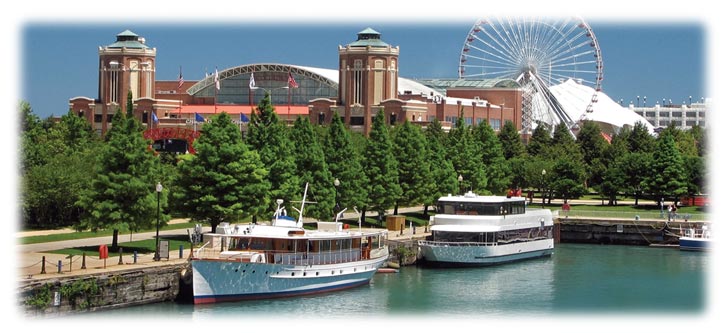
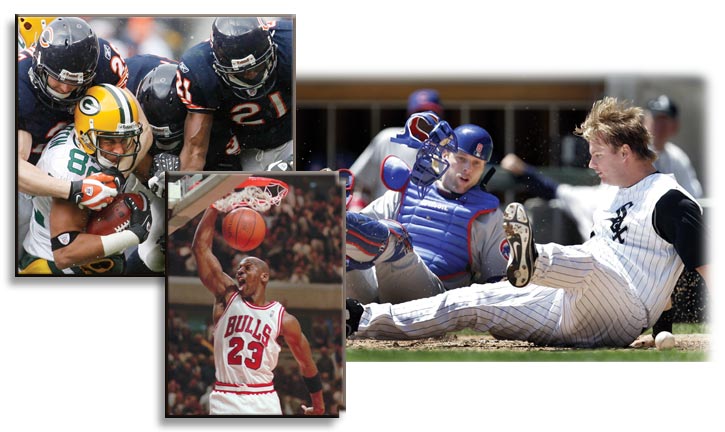

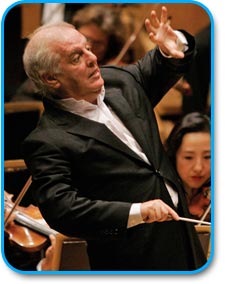 The Civic Orchestra of Chicago is the training orchestra of the CSO and performs free concerts in the Symphony Center. Also at no charge are the Grant Park Symphony and Chorus performances in Grant Park.
The Civic Orchestra of Chicago is the training orchestra of the CSO and performs free concerts in the Symphony Center. Also at no charge are the Grant Park Symphony and Chorus performances in Grant Park.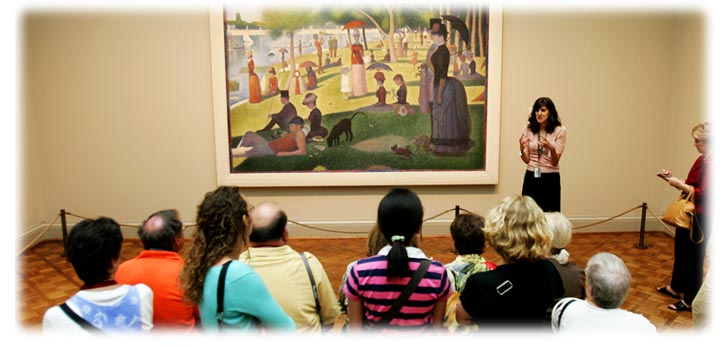
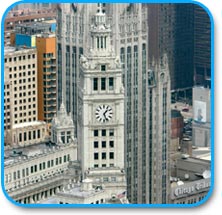 In the years after the Great Fire of 1871, like a phoenix rising from the ashes, a boom of innovative architecture remade Chicago. In the wake of the tragedy, that consumed 17,450 buildings, local architects bravely responded by giving modern civilization a classically American invention: the skyscraper. The ingenuity of Chicago's architects readily combined with new technologies -including metal skeletal construction, elevators, and electricity - to provide the necessary ingredients to build skyward. Architectural historians acknowledge William LeBaron Jenney's 1884 design of the Home Insurance Building as the world's first skyscraper. Though the building was demolished in 1931, a roster of Chicago architects continued to follow Jenney's lead by gazing ever upward. Today, the resulting skyline provides residents and tourists alike with ample opportunity to look up -and down for that matter.
In the years after the Great Fire of 1871, like a phoenix rising from the ashes, a boom of innovative architecture remade Chicago. In the wake of the tragedy, that consumed 17,450 buildings, local architects bravely responded by giving modern civilization a classically American invention: the skyscraper. The ingenuity of Chicago's architects readily combined with new technologies -including metal skeletal construction, elevators, and electricity - to provide the necessary ingredients to build skyward. Architectural historians acknowledge William LeBaron Jenney's 1884 design of the Home Insurance Building as the world's first skyscraper. Though the building was demolished in 1931, a roster of Chicago architects continued to follow Jenney's lead by gazing ever upward. Today, the resulting skyline provides residents and tourists alike with ample opportunity to look up -and down for that matter.
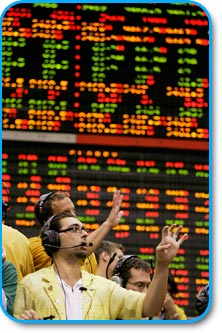 It would be hard to imagine any city with a more advantageous location for business than Chicago. Since its inception, the City of the Big Shoulders has proven to be a crucial link between the forests and mines to the north, the farms of the heartland, the coalfields to the south, and the urban population centers of the East Coast.
It would be hard to imagine any city with a more advantageous location for business than Chicago. Since its inception, the City of the Big Shoulders has proven to be a crucial link between the forests and mines to the north, the farms of the heartland, the coalfields to the south, and the urban population centers of the East Coast.